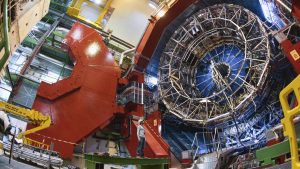Just a few millionths of a second after the Big Bang, the entire Universe was filled with a plasma composed of quarks and gluons, fundamental entities of matter and nuclear force.
The LHC (Large Hadron Collider) at the CERN of Geneva is the largest particle accelerator ever built, capable of accelerating protons and heavy ions to ultra-relativistic energies. By colliding lead ions, LHC is able to reproduce in the laboratory a “Little Bang”, namely very high temperature (trillions of degrees Celsius) and density conditions, similar to those that gave rise to the primordial plasma.
The ALICE detector (A Large Ion Collider Experiment) can identify the tens of thousands of particles that originate from the decay of the plasma created at each collision. These measurements provide an enormous amount of information (several thousand terabytes of data each year) that reveal details ranging from the mechanism governing the early Universe to the characteristics of the strong nuclear force, from the hadron production mechanism to the study of neutron stars.
ALICE differs from the other LHC experiments because of its great ability to identify the various species of ordinary particles produced by the decay of the primordial plasma bubble. In fact, an extremely accurate characterization of the “fingerprints” left in the final distributions of the particles originating from the plasma is essential to understand its dynamics.
The ALICE experiment can be seen as an underground “telescope” aimed at a Big Bang recreated in the laboratory by the extraordinary “time machine” of the LHC accelerator.
In recent years, in view of the further increase in energy and collision frequency expected for LHC from 2021 onwards, the ALICE experiment is undergoing a series of upgrades to maximize its performance. In particular, the two main tracker detectors have been replaced or modified. INFN and Frascati National Laboratories have made an essential contribution to this program by constructing a substantial part of the inner tracker (the one closest to the collision point) that is characterized by an innovative pixel sensor technology with enormous resolution (12500 megapixels in total) and flexibility, which can also be exploited in a wide range of application fields (with particular reference to nuclear medicine for cancer treatment).
 INFN-LNF Laboratori Nazionali di Frascati
INFN-LNF Laboratori Nazionali di Frascati
